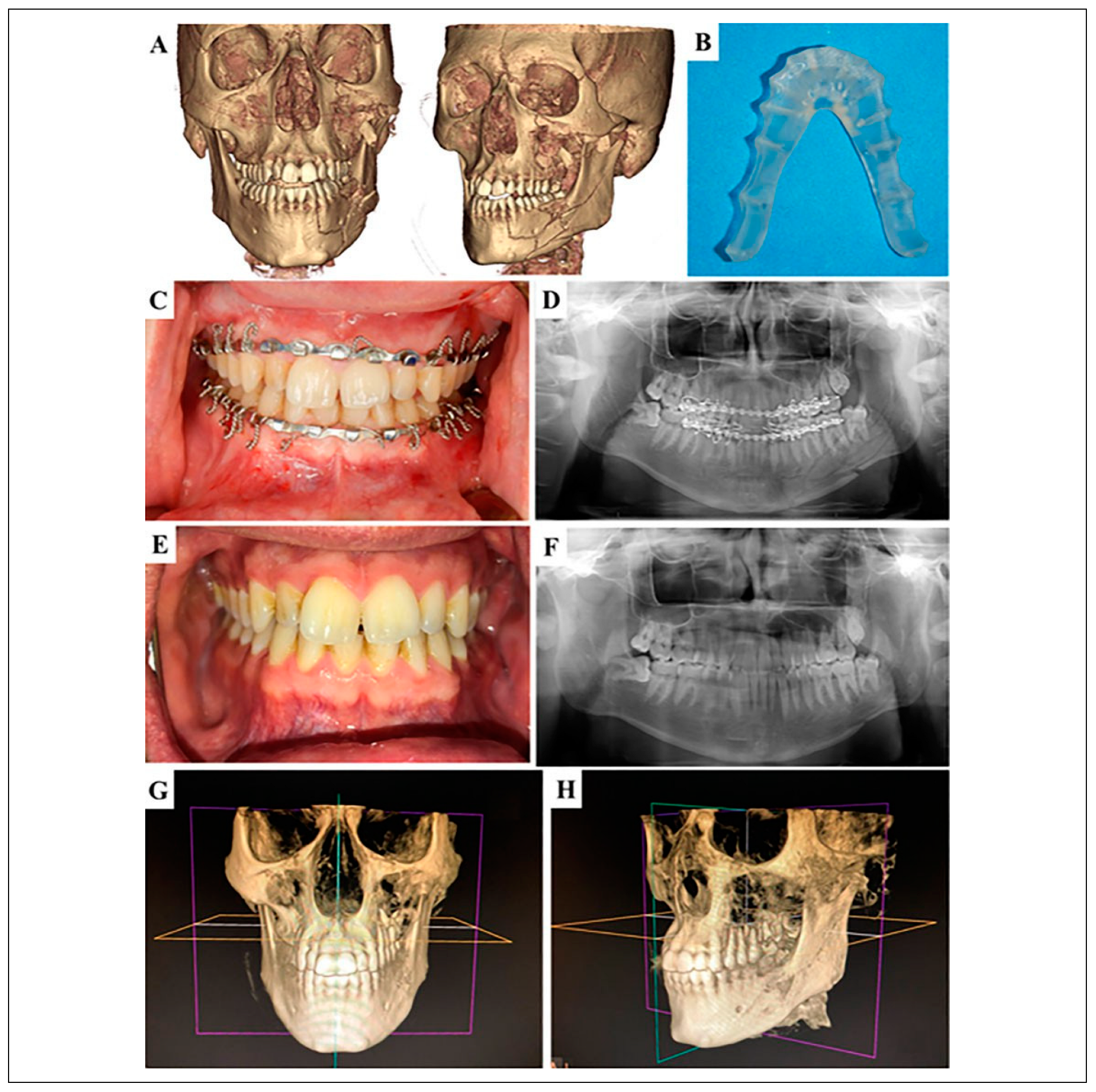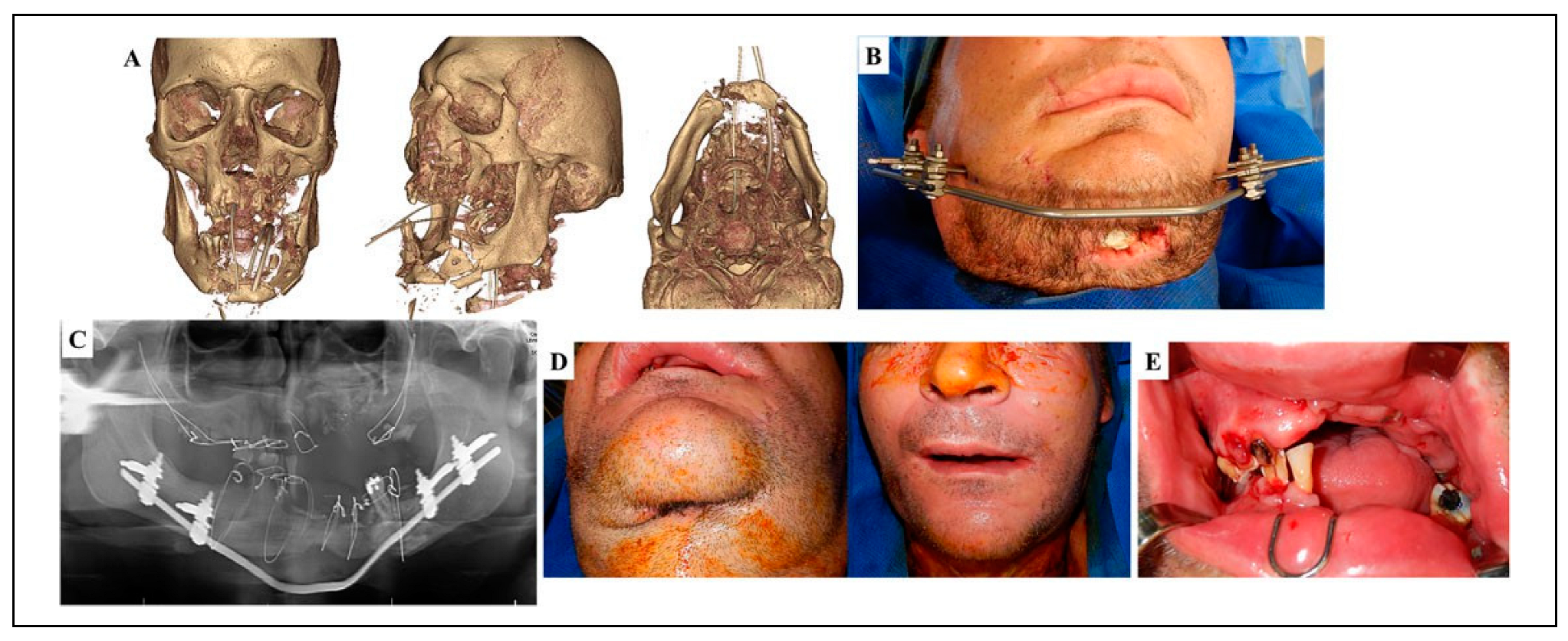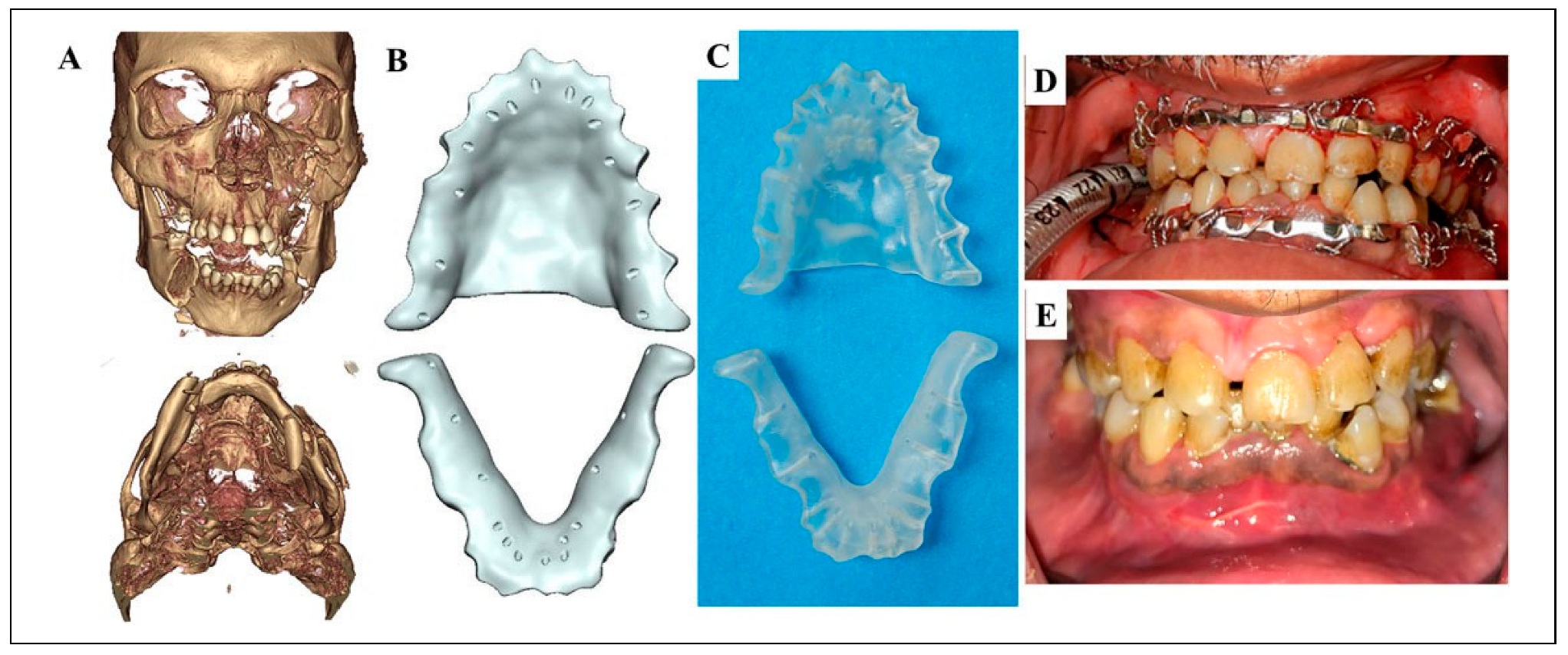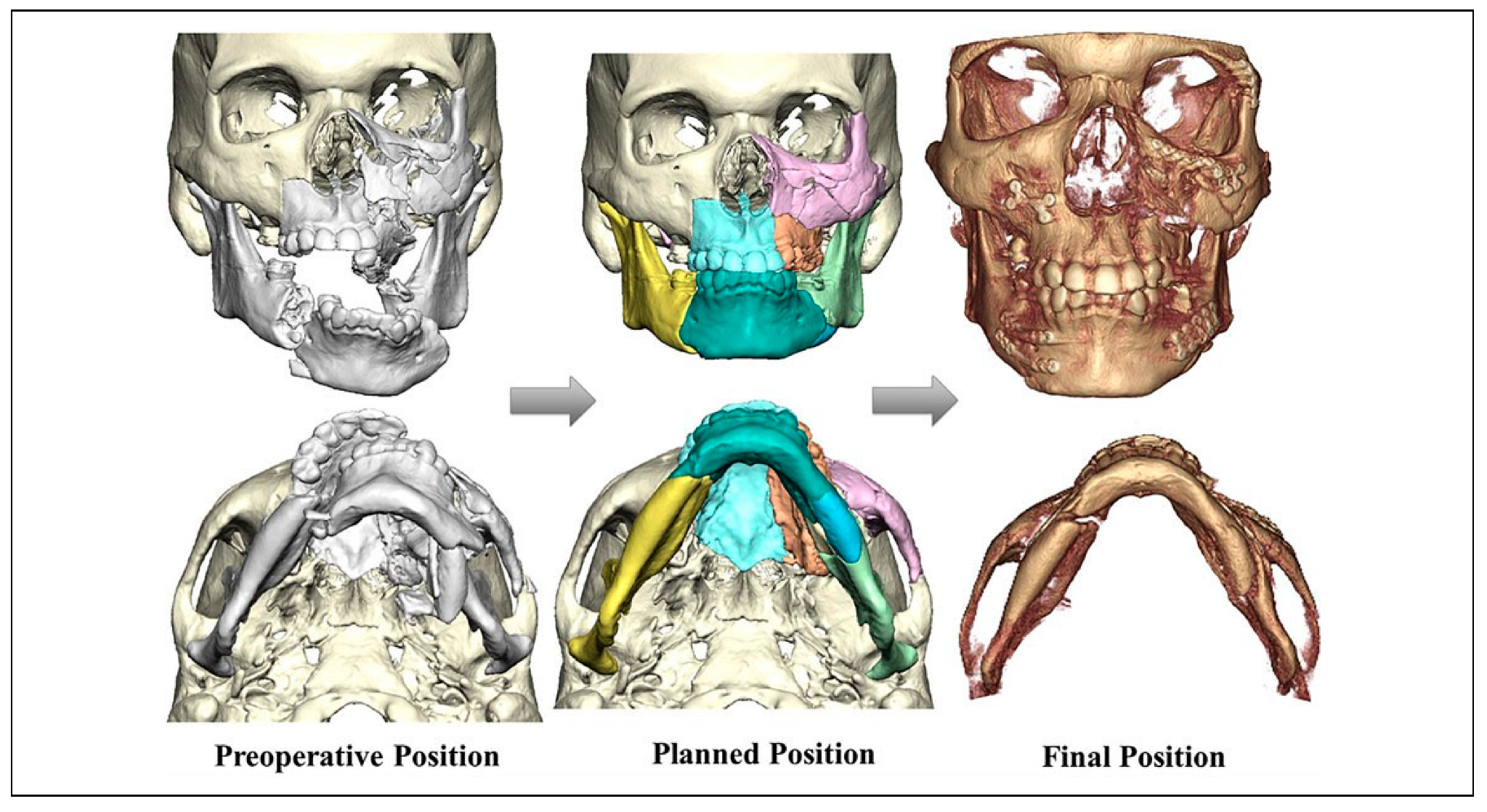Utilization of Virtual Surgical Planning for Surgical Splint-Assisted Comminuted Maxillomandibular Fracture Reduction and/or Fixation
Abstract
:Introduction
Methods
Data Acquisition and Presurgical Planning
Surgical Procedure
Results
Discussion
Conclusion
Funding
Acknowledgments
Conflicts of Interest
Ethical Approval
References
- Patil, R.S.; Kale, T.P.; Kotrashetti, S.M.; Baliga, S.D.; Prabhu, N.; Issrani, R. Assessment of changing patterns of Le Fort fracture lines using computed tomography scan: an observational study. Acta Odontol Scand. 2014, 72, 984–988. [Google Scholar]
- Alpert, B.; Tiwana, P.S.; Kushner, G.M. Management of comminuted fractures of the mandible. Oral Maxillofac Surg Clin North Am. 2009, 21, 185–192. [Google Scholar] [PubMed]
- Gentile, M.A.; Tellington, A.J.; Burke, W.J.; Jaskolka, M.S. Management of midface maxillofacial trauma. Atlas Oral Maxillofac Surg Clin North Am. 2013, 21, 69–95. [Google Scholar]
- Ellis, E., 3rd; Muniz, O.; Anand, K. Treatment considerations for comminuted mandibular fractures. J Oral Maxillofac Surg. 2003, 61, 861–870. [Google Scholar] [PubMed]
- Cohen, S.R.; Leonard, D.K.; Markowitz, B.L.; Manson, P.N. Acrylic splints for dental alignment in complex facial injuries. Ann Plast Surg. 1993, 31, 406–412. [Google Scholar] [PubMed]
- Chidyllo, S.A.; Jacobs, J.S. Applications of dental splints with regard to modern techniques of rigid fixation. J Craniofac Surg. 1994, 5, 136–141. [Google Scholar] [CrossRef]
- Konas, E.; Tuncbilek, G.; Kayikcioglu, A.; Akcan, C.A.; Kocadereli, I.; Mavili, M.E. Splint-assisted reduction of comminuted or complex maxillofacial fractures. J Craniofac Surg. 2011, 22, 1471–1475. [Google Scholar]
- Blitz, M.; Notarnicola, K. Closed reduction of the mandibular fracture. Atlas Oral Maxillofac Surg Clin North Am. 2009, 17, 1–13. [Google Scholar]
- Bell, R.B. Computer planning and intraoperative navigation in cranio-maxillofacial surgery. Oral Maxillofac Surg Clin North Am. 2010, 22, 135–156. [Google Scholar]
- Louvrier, A.; Marty, P.; Barrabe, A.; et al. How useful is 3D printing in maxillofacial surgery? J Stomatol Oral Maxillofac Surg. 2017, 118, 206–212. [Google Scholar]
- Jacobs, C.A.; Lin, A.Y. A new classification of three-dimensional printing technologies: systematic review of three-dimensional printing for patient-specific craniomaxillofacial surgery. Plast Reconstr Surg. 2017, 139, 1211–1220. [Google Scholar] [PubMed]
- Levine, J.P.; Patel, A.; Saadeh, P.B.; Hirsch, D.L. Computer-aided design and manufacturing in craniomaxillofacial surgery: the new state of the art. J Craniofac Surg. 2012, 23, 288–293. [Google Scholar] [CrossRef]
- Gelesko, S.; Markiewicz, M.R.; Bell, R.B. Responsible and prudent imaging in the diagnosis and management of facial fractures. Oral Maxillofac Surg Clin North Am. 2013, 25, 545–560. [Google Scholar] [CrossRef]
- Castro-Núñez, J.; Shelton, J.M.; Snyder, S.; Sickels, J.V. Virtual surgical planning for the management of severe atrophic mandible fractures. Craniomaxillofac Trauma Reconstr. 2018, 11, 150–156. [Google Scholar] [CrossRef] [PubMed]
- Morrison, C.S.; Taylor, H.O.; Collins, S.; Oyelese, A.; Sullivan, S.R. Use of intraoperative computed tomography in complex craniofacial trauma: an example of on-table change in management. Craniomaxillofac Trauma Reconstr. 2014, 7, 298–301. [Google Scholar] [CrossRef] [PubMed]
- Thor, A. Preoperative planning of virtual osteotomies followed by fabrication of patient specific reconstruction plate for secondary correction and fixation of displaced bilateral mandibular body fracture. Craniomaxillofac Trauma Reconstr. 2016, 9, 188–194. [Google Scholar] [CrossRef]
- Li, P.; Tang, W.; Liao, C.H.; Tan, P.Y.; Zhang, J.K.; Tian, W.D. Clinical evaluation of computer-assisted surgical technique in the treatment of comminuted mandibular fractures. J Oral Maxillofac Surg Med Pathol. 2015, 27, 332–336. [Google Scholar]
- Martelli, N.; Serrano, C.; van den Brink, H. , et al. Advantages and disadvantages of 3-dimensional printing in surgery: a systematic review. Surgery. 2016, 159, 1485–1500. [Google Scholar] [CrossRef]
- Tepper, O.M.; Sorice, S.; Hershman, G.N.; Saadeh, P.; Levine, J.P.; Hirsch, D. Use of virtual 3-dimensional surgery in post-traumatic craniomaxillofacial reconstruction. J Oral Maxillofac Surg. 2011, 69, 733–741. [Google Scholar]
- Wagner, J.D.; Baack, B.; Brown, G.A.; Kelly, J. Rapid 3-dimensional prototyping for surgical repair of maxillofacial fractures: a technical note. J Oral Maxillofac Surg. 2004, 62, 898–901. [Google Scholar] [CrossRef]
- Kokosis, G.; Davidson, E.H.; Pedreira, R.; Macmillan, A.; Dorafshar, A.H. The use of computer-aided design and manufacturing in acute mandibular trauma reconstruction. J Oral Maxillofac Surg. 2018, 76, 1036–1043. [Google Scholar] [PubMed]
- Sinha, P.; Skolnick, G.; Patel, K.B.; Branham, G.H.; Chi, J.J. A 3-dimensional-printed short-segment template prototype for mandibular fracture repair. JAMA Facial Plast Surg. 2018, 20, 373–380. [Google Scholar] [PubMed]
- Wang, H.D.; Frost, C.; Cusano, A.; Dorafshar, A.H. Management of bilateral edentulous mandible fractures through an intraoral approach using CAD/CAM technology: a case report. J Oral Maxillofac Surg. 2018, 76, e1–e1056. [Google Scholar]
- Ma, J.L.; Ma, L.M.; Wang, Z.F.; Zhu, X.J.; Wang, W.J. The use of 3D-printed titanium mesh tray in treating complex comminuted mandibular fractures: a case report. Medicine (Baltimore). 2017, 96, 1–5. [Google Scholar]
- el-Gengehi, M.; Seif, S.A. Evaluation of the accuracy of computer-guided mandibular fracture reduction. J Craniofac Surg. 2015, 26, 1587–1591. [Google Scholar]
- Khatib, B.; Cuddy, K.; Cheng, A.; et al. Functional anatomic computer engineered surgery protocol for the management of self-inflicted gunshot wounds to the maxillofacial skeleton. J Oral Maxillofac Surg. 2018, 76, 580–594. [Google Scholar]
- Lee, J.-W.; Choi, B.-J.; Nam, O.-H.; Kwon, Y.-D. Minimal invasive treatment using patient-specific template for mandibular fractures in children: “Wing-splint” by CAD/CAM technology. Br J Oral Maxillofac Surg. 2016, 54, 1140–1141. [Google Scholar]
- Peleg, M.; Sawatari, Y. Management of gunshot wounds to the mandible. J Craniofac Surg. 2010, 21, 1252–1256. [Google Scholar]
- Meara, D.J.; Jones, L.C. Controversies in maxillofacial trauma. Oral Maxillofac Surg Clin North Am. 2017, 29, 391–399. [Google Scholar]






© 2020 by the authors. The Authors 2020.
Share and Cite
Kongsong, W.; Sittitavornwong, S. Utilization of Virtual Surgical Planning for Surgical Splint-Assisted Comminuted Maxillomandibular Fracture Reduction and/or Fixation. Craniomaxillofac. Trauma Reconstr. 2020, 13, 334-341. https://doi.org/10.1177/1943387520948677
Kongsong W, Sittitavornwong S. Utilization of Virtual Surgical Planning for Surgical Splint-Assisted Comminuted Maxillomandibular Fracture Reduction and/or Fixation. Craniomaxillofacial Trauma & Reconstruction. 2020; 13(4):334-341. https://doi.org/10.1177/1943387520948677
Chicago/Turabian StyleKongsong, Wichuda, and Somsak Sittitavornwong. 2020. "Utilization of Virtual Surgical Planning for Surgical Splint-Assisted Comminuted Maxillomandibular Fracture Reduction and/or Fixation" Craniomaxillofacial Trauma & Reconstruction 13, no. 4: 334-341. https://doi.org/10.1177/1943387520948677
APA StyleKongsong, W., & Sittitavornwong, S. (2020). Utilization of Virtual Surgical Planning for Surgical Splint-Assisted Comminuted Maxillomandibular Fracture Reduction and/or Fixation. Craniomaxillofacial Trauma & Reconstruction, 13(4), 334-341. https://doi.org/10.1177/1943387520948677



